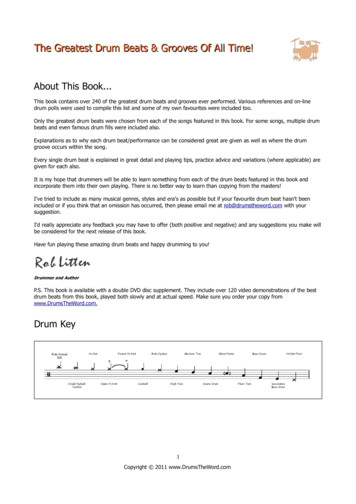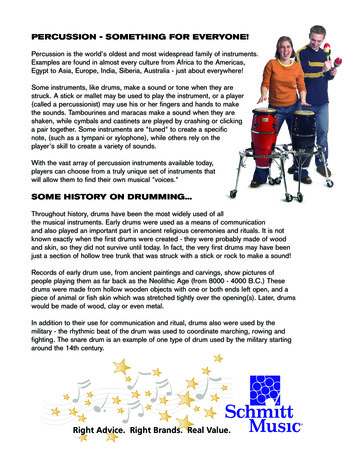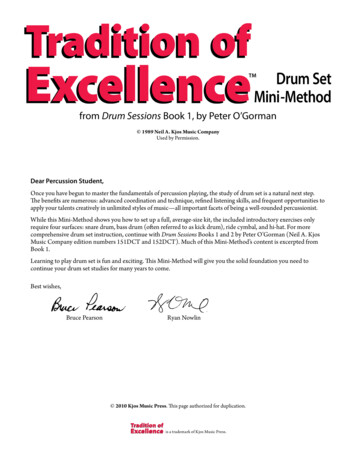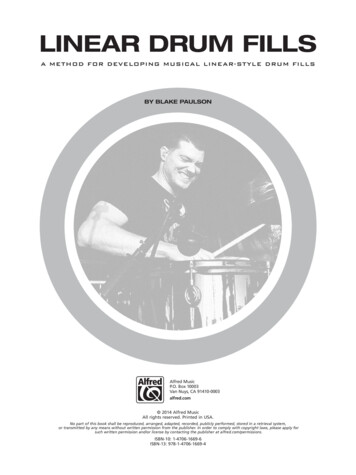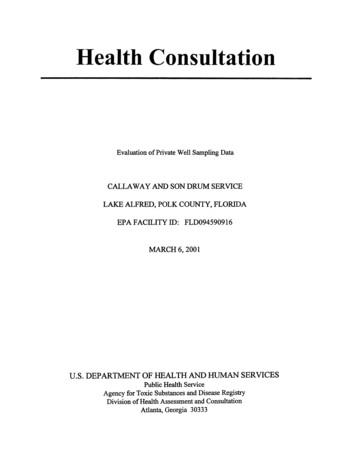
Transcription
Evaluationof PrivateWell SamplingDataCALLA WAY AND SONDRUM SERVICELAKE ALFRED, POLK COUNTY, FLORIDAEPA FACILITY ill:FLDO94590916MARCH 6, 2001u.s. DEPART:MENT OF HEALTH AND HUMAN SERVICESPublic HealthServiceAgency for Toxic SubstancesandDiseaseRegistryDivision of Health Assessmentand ConsultationAtlanta,Georgia 30333
Health Consultation: A Note of ExplanationAn A TSDR health consultation is a verbal or written responsefrom A TSDR to a specific requestforinfonnation about health risks related to a specific site, a chemical release, or the presence ofhazardousmaterial. In order to prevent or mitigate exposures,a consultation may lead to specificactions, suchasrestricting use of or replacing water supplies; intensifying environmental sampling;restricting site access;or removing the contaminatedmaterial.In addition, consultations may recommend additional public health actions, such as conductinghealth surveillance activities to evaluateexposureor trends in adversehealth outcomes; conductingbiological indicators of exposure studies to assessexposure; and providing health education forhealth careproviders and community members. This concludesthe health consultation process forthis site, unless additional information is obtained by A TSDR which, in the Agency's opinion,indicates a need to revise or appendthe conclusions previously issued.You May ContactATSDR TOLL FREEat1-888-42ATSDRorVisit our HomePageat: http://atsdrl.atsdr.cdc.gov:8080/
HEALTH CONSULTAllONEvaluationof PrivateWell SamplingDataCALLAWAY AND SON DRUM SERVICELAKE ALFRED, POLK COUNTY, FLORIDAEPA FACILITY ill:FLDO94590916Prepared by:Florida Departmentof HealthBureauof EnvironmentalEpidemiologyUndera CooperativeAgreementwith theAgencyfor Toxic SubstancesandDiseaseRegistry
Callaway and Son Drum Service, Public Health ConsultationSTATEMENT OF ISSUESOn August 15, 2000, the Florida Department of Health (FDOH) held a public availabilitysession regarding the Callaway and Son Drum Service hazardous waste site. At themeeting, FDOH announced the findings of their public health assessment and offered totest nearby potaQle private wells. FDOH determined that a Health Consultation is anappropriate means to present drinking water data from private wells surrounding ahazardous waste site. The interpretation, advice, and recommendations presented in thisHealth Consultation are site-specific and should not be considered applicable to any othersite. The federal Agency for Toxic Substances and Disease Registry (ATSDR) in Atlanta,Georgia, provides 100% of the funding for these activities.INTRODUCTIONThe Callaway and Son Drum Service hazardous waste site is at 890 East lake Drive (US17 -92) in lake Alfred, Polk County, Florida (Figure 1). The site posts a "Callaway and SonSatellite Systems" sign, corresponding to the business that occupied the site after the drumservice. The site covers approximately 9.5 acres and consists of a drum cleaning area, asandblasting and painting area, and a drum storage area (Figure 2). A vacant officebuilding occupies the southern portion of the site. The northern border of the site is a railline, which separates the site from a University of Florida Agriculture Experiment Station.A plant nursery is south of the site and the lake Alfred sewage treatment plant is due west.A cemetery and an apartment complex are east of the site.land use in this area is a mix of commercial and residential. The apartments east of thesite are the nearest residential buildings. Across East lake Drive (US 17-92) to thesoutheast and southwest within one-half of a mile of the site are communities with manyhomes.Residential properties are also northwest of the site.Commercial andnonresidential establishments exist west, north, and northeast of the site. Three schoolsare within one mile of the site.An elementary school and a career center areapproximately 1 mile southwest of the site and another school is 0.3 miles northwest of thesite. Each of these schools receives municipal water service. Based on the 1990 census,approximately 1300 people live within 1 mile of the site (Table 1).Groundwater in this area is contained in two aquifers. The surficial aquifer extends frombeneath the surface to about 50 to 75 feet deep. This aquifer provides a low yield of poorquality water. Most private potable and municipal wells are drilled into the Floridan aquifer,which lies beneath the surficial aquifer and extends several hundred feet deep.Groundwater in both aquifers reportedly flows in a southerly direction.Between 1977 and 1991, Callaway and Son Drum Service cleaned and recycled 55-galloncitrus and oil drums. The company cleaned the drums with a resin solution and then rinsedthem in a eOO-gallon fresh water tank. The facility processed about 20 drums per day, 5days a week. During the citrus season, however, Callaway and Son Drum Service handledup to 500 drums per day (FDER, 1992). The company drained the rinse tank into thepond/wetland area on the eastern portion of the property every two weeks (EPA, 1994).Currently, no business operations exist on-site.2
Callaway and Son Drum Service, Public Health ConsultationPrivate Well TestingIn February 2000, the federal Environmental Protection Agency (EPA) proposed theCallaway and Son Drum Service site to the National Priorities List (NPl) of hazardouswaste sites. In response, FDOH reviewed all available environmental data and conducteda public health a sessment on this site. In the public health ass ssment report, FDOHclassified this site as an "indeterminate public health hazard" based on the limited amountof data. FDOH also made recommendations to area residents and environmentalagencies to prevent exposure to site contaminants (FDOH, 2001). On August 15, 2000,FDOH presented the public health assessment report to area residents at a publicavailability session held at the lake Alfred City Hall. Several residents expressed aconcern about the effect of this site on the area groundwater and private water supplies.Therefore, FDOH, in cooperation with the Polk County Health Department (PCHD), offeredto test private potable wells within 0.25 miles of the site, at the well owner's request. In theimmediate area, most homes receive municipal water service, including the neighboringapartment complex. However, some homes use private or community wells as a sourceof potable water.During the public availability session, FDOH and PCHD received requests from eight wellowners to have their well water tested for contaminants from the Callaway site. FDOH andPCHD also tested the City of lake Alfred municipal water supplies. On September 7,2000, PCHD personnel collected water samples from the municipal well and eight privatewells near the Callaway site. Of these eight wells, five are single household wells locatedsoutheast of the site. Another private well is also southeast of the site but serves a largerpopulation (-75). Of the two remaining private wells, one is immediately south of the site.This well is in closest proximity to the site and reportedly is used for irrigation. The last ofthe eight private wells tested is approximately one mile southwest from the site. Themunicipal well is slightly less than one mile west of the site. The legend below Table 2 liststhe location of these wells in relation to the site. Figure 1 shows the approximate locationof the these wells. Reportedly, most area potable and irrigation wells are drilled into theFloridan aquifer, because of its high productivity (EPA, 1994).Quality Assurance and Quality ControlPCHD adhered to collection methods that are applicable for samples where volatilecompounds are to be analyzed.Appropriate chain-of-custody and data reportingprocedures were followed and appropriate laboratory, equipment and sample controls wereanalyzed. The completeness and reliability of the referenced information determine thevalidity of the analyses and conclusions drawn in this health consultation. The laboratoryanalyzed each water sample for arsenic, lead, chromium, dichloroethylene, methyl-tertbutyl ether, tetrachloroethylene, trichloroethylene, and vinyl chloride, among other organiccompounds.FDOH focused on these specific chemicals since EPA and FDEP hadpreviously detected each of these in the groundwater beneath the Callaway site (FDER,1984; 1986; 1992; EPA, 1994). In addition, FDOH had chosen these compounds as thechemicals of concern in the public health assessment (FDOH, 2001).3
Cal/away and Son Drum Service, Public Health ConsultationRESULTSAll nine water samples contained detectable levels of arsenic. However, none of thearsenic levels exceeded the Florida drinking water standard. The arsenic levels are alsowithin the range of what can normally be detected in Florida groundwater. Arsenic is ametal that naturally occurs and can be found in numerous mediums, including groundwaterand soil. Two of the nine water samples contained chromium and four of the nine samplescontained lead. The levels of these metals, like arsenic, do not exceed the respectiveFlorida drinking water standard. In addition, the levels of chromium and lead in thesesamples are consistent with background concentrations in Florida groundwater. Chromiumand lead, like arsenic, are naturally occurring metals that are commonly found in soils andgroundwater. Table 2 summarizes the analytical results for each sample.Only one of the nine well water samples contained any of the organic compounds detectedin the groundwater beneath the Callaway site. Well #7, immediately south of the site,contained cis-dichloroethylene,methyl-tefl-butylether, tetrachloroethylene,andtrichloroethylene (Table 2). The laboratory detected each of these chemicals at a levelbelow its Florida drinking water standard.CHILDREN AND OTHER UNUSUALLY SUSCEPTIBLEPOPULATIONSThe unique vulnerabilities of infants and children demand special emphasis in communitiesfaced with the contamination of their environment. Children are at a greater risk thanadults from certain kinds of exposure to hazardous substances. They are more likely tobe exposed because they play outdoors and because they often bring food intocontaminated areas. They are shorter than adults, which means they breathe dust, soil,and heavy vapors close to the ground. Children are also smaller, resulting in higher dosesof chemical exposure per body weight. In addition, the developing body systems ofchildren can sustain permanent damage if toxic exposures occur during critical growthstages. Most important, children depend completely on adults for risk identification andmanagement decisions, housing decisions, and access to medical care. Children are aspecial consideration in regards to this site because children may be more sensitive toseveral of the contaminants that were previously detected. Children may absorb metalsfrom the intestine more efficiently than adults and may be more sensitive to the toxicity ofmetals and chlorinated solvents. FDOH does not anticipate this site introducing a healthrisk specifically to children, since no completed exposure pathway is present. EPA hasrecently restricted access to the site and the levels of contaminants that are likely tomigrate off of the site (i.e., solvents) are not likely to reach a potable well at a concentrationthat would likely result in a hazardous dose to a child.CONCLUSIONS1The arsenic, chromium and lead in these well water samples are unlikely the resultof contamination from the Callaway and Son site because:aThe concentrations of these metals are typical of Florida 9 rou ndwater.4
a.Callaway and Son Drum Service, Public Health Consultationb.In general, arsenic, chromium and lead tend to associate with soilparticles and therefore, do not migrate with groundwater flow(ATSDR, 1998; 1999a; 1999b).2.Since the concentrations of arsenic, chromium, and lead do not exceed the Floridadrinking water standards, FDOH does not anticipate regular ingestion or residentialuse of well water containing low levels of these metals to cause illness.3The presence of the ethyleneandmethyl-tert-butylether in well sample #7, immediately south of the site, is likely theresult of contaminationfrom the Callaway and Son site because:Unlike metals, these chemicals travel with groundwater flow.4.b.Previous studies at this site suggest a southerly flow of groundwaterin both the surficial and Floridan aquifers.c.The profile of contaminants in the well south of the site is similar tothe profile of contaminants in the groundwater beneath the Callawayand Son site.Ingestion of these low levels of chlorinated solvents and methyl-felt-butyl ether fromthe well just south of the site is unlikely to cause illness because:aThe level of each contaminant is well below its respective Floridadrinking water standard.b.This well is reportedly used for irrigation,property receives municipal water service.The business at this5Site contaminants appear to have migrated to the Floridan aquifer. Previoussampling from the on-site, Floridan well (-130 feet) showed no contamination(FDER, 1984). However, the well south of the site is drilled to a depth ofapproximately 100 feet, which is the upper Floridan aquifer. The Floridan aquiferprovides much of the potable water for this area of Florida.6.FDOH cla sifies the off-site groundwater contamination exposure pathway at theCallaway and Son site "no apparent health hazard", It is not likely that hazardousconcentrations of these contaminants will reach a potable water source.aMetals (i.e. arsenic, lead etc.) do not generally migrate well withgroundwater flow and are therefore, unlikely to reach a potable waterwell. See conclusion #1 b.b.The concentration of chlorinated solvents, which migrate very wellwith groundwater flow, is likely to be diluted by the groundwater to theextent that if these compounds did reach a potable well, theconcentration would likely be too low to cause illness (FDOH, 2001).5
Callaway and Son Drum Service, Public Health ConsultationRECOMMENDATIONSTo aid in identifying the extent of deep groundwater contamination, FDOH recommendsthat environmental agencies begin to regularly test the on-site Floridan aquiferwell and theneighboring Floridan well immediately south of the site (Well #7). Although FDOH doesnot anticipate these solvents to cause illness in the future, regular testing of these deepwells will aid in monitoring the movement of the contaminants in the "potable" aquifer.PUBLIC HEALTH ACTION PLAN1.FDOH will provide each wellcorresponding to their well.2.FDOH will provide a copy of this Health Consultation to each well owner, the PCHD,and Lake Alfred city officials.3.FDOH will request that environmental agencies continue to test the well south of thesite (Well #7) and if requested, FDOH will evaluate the results.4.When available, FDOH will evaluate future data and the sampling plans to gatheradditional data.owner6a copy of the watersampling data
Callaway and Son Drum Service, Public Health ConsultationREFERENCESATSDR (1998) Toxicological profile for chromium, Draft (Update). Agency for ToxicSubstances and Disease Registry, U.S. Department of Health and Human Services.A TSDR (1999a) Toxicological profile for arsenic (Update). Agency for Toxic Substancesand Disease Registry, U.s. Department of Health and Human Services.A TSDR (1999b) Toxicological profile for lead (Update). Agency for Toxic Substances andDisease Registry, U.S. Department of Health and Human Services.EPA (1994) Expanded site inspection. Callaway and Son Drum Service. Lake Alfred, PolkCounty, Florida.FDER (1984) Site Investigation Report #84-11. Callaway and Son Drum Reconditioning.lake Alfred, Polk County, Florida.FDER (1986) Groundwater investigation report number 86-15, Lake Alfred Fuel Spill, PolkCounty Florida.FDOH (2001) Public Health Assessment: Callaway and Son Drum Service, Lake Alfred,Polk County, Florida. Cerclis No. FLD094590916.FDER (1992) Phase II Site Inspection Report. Callaway and Son Drum Service. lakeAlfred, Polk County, Florida.7
Callaway and Son Drum Service, Public Health ConsultationPREPARERS OF REPORTFlorida Deoartment of Health. AuthorDavis H. Daiker, Ph.D.Division of EnvironmentalHealthBureau of EnvironmentalEpidemiologyATSDR Reviewer:Debra GableState Program SectionDivision of Health Assessment and Consultation8
Callaway and Son Drum Service, Public Health Consultation0 Approximatewell locationFigure 1. Site and Well Locations
t.N.OAKWOODCEMETARY '--', !I'J: ; -I "'-.! :: :: ::: :::::: :: ::::::: I;iFENCEFORMERIPLAYGROUND!III!'r'/////M PONDI WETLANDAREAREDWOOD.- j I";AREA.-,i--IIIl:::::::7SANDBLASTINGAND PAINTINGAREA'--I,TO LAKE HAINES1000 FEET FROMSITEFigure 2. Site Layout{:;,
.::J,,cn00::;:R::JcnQ) c;Q)-0'it-.CDU)0 000IIcncnO;:;.";:;." RCD-CDCD10.D) Q)CDI.I (1100I\.)CJ10- N000(IICJ100.(1100000000001(IIV## 0D) 0. CJ1N0(11(110000.I0(II00-,-0I\.)00(11 r -h-."i"cn00(/).,CJ1I0r CD-;'(/)(/)Q)Q)O' ' Q)-. - - -"I"U"UQ) -0 3. c.ow 00cn' Q)c;-0Q)r CDr CDc.0c;Q)c.CD"U"U -iQ)g: 0"r "0Q)r Q)-ocCDOcnQ)c-"'g9.x -imc.Q)r CD::J 3 Q)ocnr r CD -"-om"UQ) ,-*cn.-*0::J Q)"T1OvSo3C3xQ) *::J0 Q)0"0C"U3c3 ::J "S''CD 'CD-::J::JCD""" CD""" -CCDr r -.of000- .'f3o(")()0- ' Q)c;r -0r CDc."000. ()0S'33-"0"0()'its:s: Q)-.of05."E."UCD 'CD;:;."::JO"Uw-0o-0-cn00."C-Q)CD-:TCD03CD"0--' ' 0.(")033()Q)5.CDg- 'CDO"UD) -.CDCD3. CD R-c10U)-O-;:;."::J0.S'-::;:RO::JO 0-1 ,";i -CD)-'"'"'-D)0- -.of-.c:3 - mU) -"U-.c:0c- 0"C-20S'-I.-"0CDo';:;:::!".0 IU ()0fuI ::rQ:5.(/)3 c.(/)'CD" ' 0-.
c:.2Sc:II)"::50():5Q)"iij:I:.2:c:.a.2JQ). -J-0)-E Q)tn (k:0).-ca.E(/)cu:.cnEC .!NQ)c:0cnc:"CIU 3:.cIUIUI-CU"iij()0 CX) ,.cCD It).-.qzf". 00;nz0z0z0qz()0zzz00zzqz00z00Nzz(:) N0 z()z0()z00'2:0z0zz0.zz qC")Q)cn-c'ro-cQ)'-cnroc::s:roC)c: c:.- c: 0-ccnc:() c:Q).-o ro'- Q) -'E0 '-0.-EQ) ro-cc: 0-Q)- ::J:S:cnQ) Q) Q) Q) Q) Q) -'-- -'- -'cn cn cn cn cn cnrorororororoQ) Q)c "60.:::J roro-CQ)Q)-0 -oc Q)OOOOOOOOQ) cn cn cn cn cn cn cn cn :s:cro -' -'- -'- -' -' -'cnW'::J ::J ::J ::J ::J ::J -'0cQ)Q).c:'-E -roQ) -cn-o't.Q)-crocoa.Q)a.:s: cn -'Q)oQ)Q)Q) Q) Q) '- -' ---ro-JQ) cc",I .01:s :s :s :s :s s :s :s DI'---cx)O).-E O.c:cc o ro - - - -c .t ro- 2 .Q-1'ro -' ro cn rE«() ()C) -0 -c -' '- .:2. ::J cn cn cn cn IEzi:i: :r:W -J(9 ooroQ)roooororo.9],::JI ." - 0 0c:: E z:():c0"'::"00 )" zz0.- a'-(1)(1).c::"' ,:J.0(1)-t :I"' ,.c::(1)CI):2:c: IqzzI"--Q)Q)-s:,Q)e.! .-c:0Q)Q).Q.I::.()I(5(J)'015e :c0u.I::." ,.Q)I::az0()N0aL() 0;a0; qz:70 a aa:zzqqqz0E"0co0-lQ)().c"E:3n.-a0; qzzzzaz00q z0C)0000;av0C!tV)000;0(X)0000; N0"t0L()00a0; 00:000:0q0-q- (V) N .- "0cncC\3c EC\3C00Q)u'c(/)L-«N
Callaway and Son Drum Service, Public Health ConsultationA TSDR PLAIN LANGUAGEGLOSSARYOF ENVIRONMENTALHEALTH TERMSRevised -15 Dec 99Adverse Health Effect: A change in body function or the structures of cells that can leadto disease or health problems.A TSDR: The Agency for Toxic Substances and Disease Registry. A TSDR is a federalhealth agency in Atlanta, Georgia that deals with hazardous substance and waste siteissues. A TSDR gives people information about harmful chemicals in their environment andtel.ls people how to protect themselves from coming into contact with chemicals.Backgroundenvironment.Level: An average or expected amount of a chemical in a specificOr, amounts of chemicals that occur naturally in a specific-environment.Cancer: A group of diseases which occur when cells in the body become abnormal andgrow, or multiply, out of controlCarcinogen:Any substance shown to cause tumors or cancer in experimental ation,and LiabilityAct(CERCLA): CERCLA was put into place in 1980. It is also known as Superfund. This actconcerns releases of hazardous substances into the environment, and the cleanup ofthese substances and hazardous waste sites. ATSDR was created by this act and isresponsible for looking into the health issues related to hazardous waste sites.Dose: The amount of a substance to which a person may be exposed, usually on a dailybasis. Dose is often explained as "amount of substance(s) per body weight per day".Environmental Contaminant: A substance (chemical) that gets into a system (person,animal. or the environment) in amounts higher than that found in Background Level, orwhat would be expected.EnvironmentalMedia: Usually refers to the air, water, and soil in which chemicals ofinterest are found. Sometimes refers to the plants and animals that are eaten by humans.Environmental Protection Agency (EPA): The federal agency that develops and enforcesenvironmental laws to protect the environment and the public's health.Hazardous Waste: Substances that have been released or thrown away into theenvironment and, under certain conditions, could be harmful to people who come intocontact with them.MRL: Minimal Risk Level. An estimate of daily human exposure -by a specified route andlength of time --to a dose of chemical that is likely to be without a measurable risk ofadverse, noncancerous effects. An MRL should not be used as a predictor of adversehealth effects.13
Callaway and Son Drum Service, Public Health ConsultationNPL: The National Priorities List. (Which is part of Superfund.A list kept by the U.S.Environmental Protection Agency (EPA) of the most serious, uncontrolled or abandonedhazardous waste sites in the country. An NPL site needs to be cleaned up or is beinglooked at to see if people can be exposed to chemicals from the site.PHA: Public Health Assessment.A repori or document that looks at chemicals at ahazardous waste site and tells if people could be harmed from coming into contact withthose chemicals. The PHA also tells if PQssible furiher public health actions are needed.SARA: The Superfund Amendments and Reauthorization Act in 1986 amended CERCLAand expanded the health-related responsibilities of A TSDR. CERCLA and SARA directA TSDR to look into the health effects from chemical exposures at hazardous waste sites.Toxic: Harmful. Any substance or chemical can be toxic at a certain dose (amount). Thedose is what determines the potential harm of a chemical and whether it would causesomeone to get sick.Toxicology:The study of the harmful effects of chemicals on humans or animals.14
Callaway and Son Drum Service, Public Health ConsultationCERTIFICATIONThis Callaway and Son Drum Service Health Consultation was prepared by the FloridaDepartment of Health under a cooperative agreement with the Agency for ToxicSubstances and Disease Registry (ATSDR).It is in accordance with approvedmethodology and proced ures existing at the time the public health assessment was beg un.De ctDivisionOfficerof Health Assessmentand ConsultationATSDRThe Division of Health Assessment and Consultation, ATSDR, has reviewed this publichealth assessment, and concurs with its findings."""",""""': :::::; : - :r::; /"1 ./ a l3 :7SectionChief, SPS, SSAB,15DHAC, A TSDR
The Callaway and Son Drum Service hazardous waste site is at 890 East lake Drive (US 17 -92) in lake Alfred, Polk County, Florida (Figure 1). The site posts a "Callaway and Son Satellite Systems" sign, corresponding to the business that occupied the site after the drum service.

